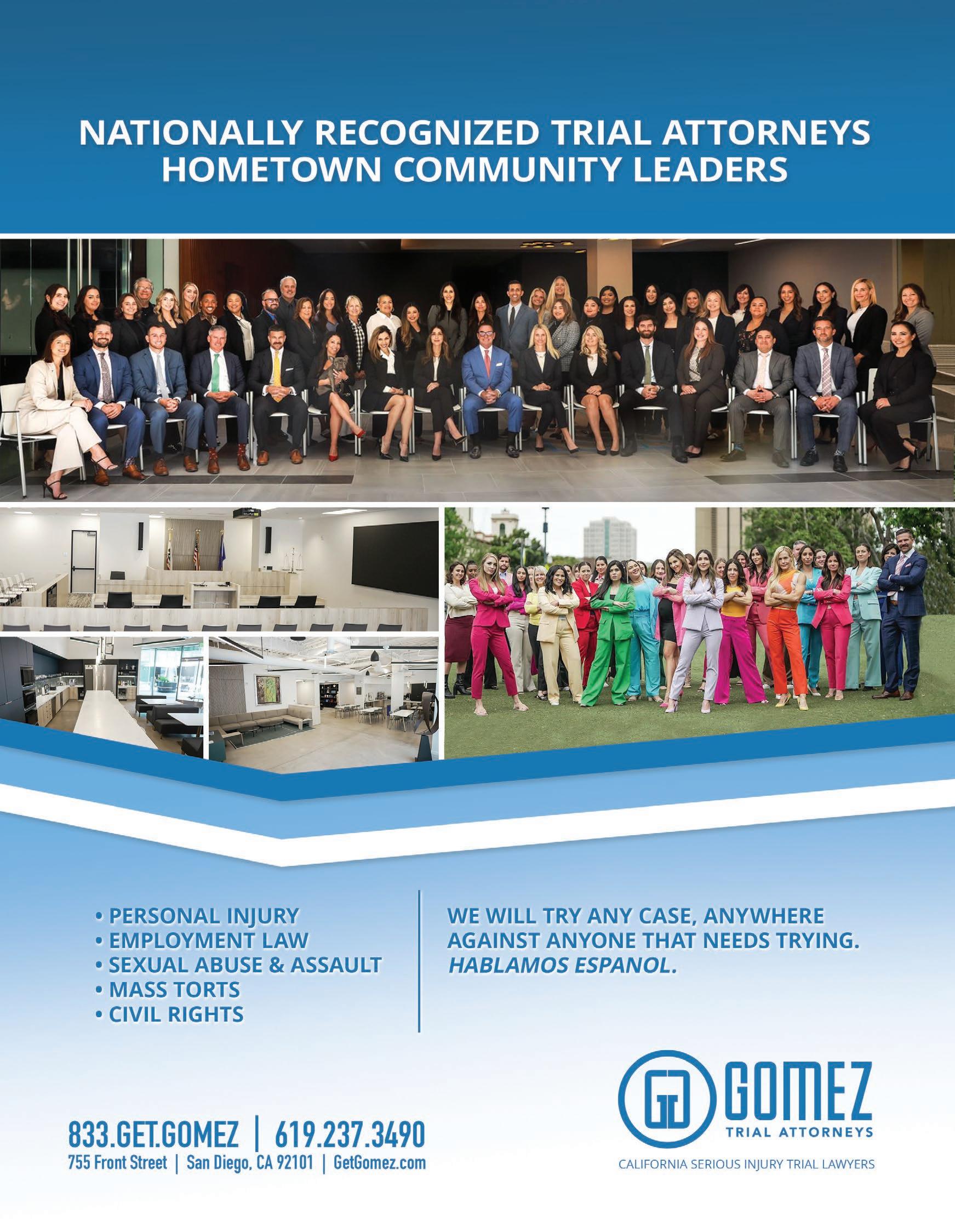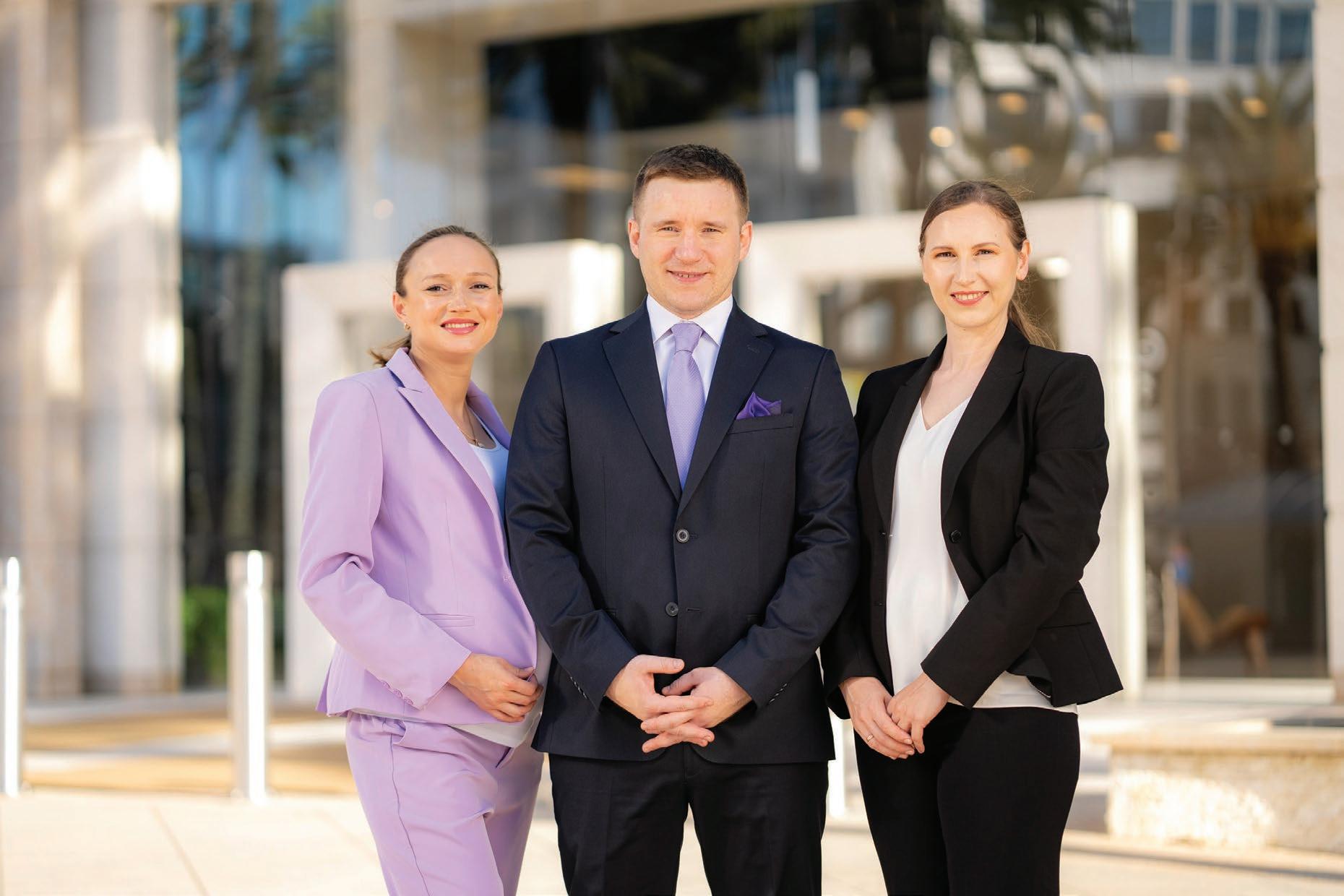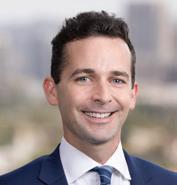The Attorney-Client Relationship: A Communication Perspective
Phillip S. Hadlock
SWOT Analysis for Law Firms
Omnizant
How Law Firms Can Stand Out with Effective Video Content on TikTok
Erin Lindberg
Top 10 Tips to Help Avoid Trouble
Douglas Chandler

The Attorney-Client Relationship: A Communication Perspective
Phillip S. Hadlock
SWOT Analysis for Law Firms
Omnizant
How Law Firms Can Stand Out with Effective Video Content on TikTok
Erin Lindberg
Top 10 Tips to Help Avoid Trouble
Douglas Chandler

Attorney of the Month
What to Make of Non-Local Job Candidates Kirk Stange
6 Pitfalls to Avoid When Choosing New Marketing Technology Solutions Noreen Fishman
How Marketing to Other Lawyers Can Grow Your Legal Practice
Stefanie Marrone
From Boutique to National: The Gilson Daub Evolution



• $22,659,551 settlement for clients defrauded in a local Ponzi scheme in Levin v. Chicago Title, et al. (2021)(Michael Kirby & Jason Kirby).
• Complete defense jury verdict in real estate dispute and more than $400,000 collected for attorneys’ fees and costs in Batter v. McElhinney, et al. (2019)(Jason Kirby).
• $2.1 million jury verdict for firm client in Doe v. San Diego Unified School District, et al. (2018)(Jason Kirby & Michael Kirby).
• $1.1 million arbitration award for firm clients on cross-complaint after zeroing plaintiff on $6 million damage claim in Step Strategy Advisors v. Solid Gold Health Products for Pets, Inc., et al. (2018)(Jason Kirby lead counsel).



































As an attorney and mediator who specializes in professional liability cases and issues affecting lawyers and their firms, I’ve learned that while the fact patterns and circumstances of every case are different, even the best lawyers can make mistakes. The dynamics of professional liability practice have taught me how to anticipate and try to prevent mistakes. With that in mind, here are my “Top 10” tips to help you avoid legal trouble as a practicing attorney:
1. Know the rules: Remember, it’s important to stay up to date on current rule updates to protect your clients and your law practice.
2. Plan for the worst and hope for the best: Protect your assets with sufficient insurance, succession plans, wills, trusts, and estate plans. Have your personal and professional policies reviewed: annually upon renewal; when you choose practice areas; when you add or remove employees; when the value of your engagements increases or decreases; and upon retirement, disability, or death. Consult a lawyer or firm with a practice focused on succession planning and asset protection for legal professionals.
3. Know thy clients: Before you take on a new client, ensure you have a thorough understanding of who that client really is, and identify the proper client in your engagement contract. Meet clients prior to undertaking representation, find out their motivation for hiring counsel, and listen closely to their responses. Watch for warning signs and red flags, such as an improper purpose for hiring counsel, financial inability to retain legal counsel, reluctance to listen to counsel, or questionable business ethics. Trust your instincts—the value of the engagement declined may far outweigh the value of the engagement undertaken.
4. Copy thy clients: Send your client a copy of what you receive and a copy of what you send out. When you do this for every communication, no commentary is necessarily required for the transmittal. Timeliness is critical so your client can make informed decisions. Remember that you can always follow up with an explanation letter or phone
By Douglas Chandler
call after the client has had time to review the communication. For important decisions based on a document sent to the client, follow up with a decision-confirming letter or email to memorialize that decision, thereby minimizing the chances of “buyer’s remorse.”
5. Communicate early and often: ALWAYS put it in writing. This is especially important when developing, declining, or ending client engagements. Clear engagement letters should define the start point, objectives, scope of work, payment terms, file retention policies, dispute provisions, and the endpoint (disengagement letter). If the “beginning” never occurs, issue non-engagement letters. Remember, some people consider one visit to an attorney’s office enough to establish an attorney-client relationship, while others believe that your duties to them continue beyond the conclusion of the case or engagement. Even if the client is a repeat business client, send a matter conclusion confirmation letter, which welcomes the client to retain you for future matters.
6. Track everything: This includes documenting all events, to-dos, and deadlines with a proper calendaring tool. Not only is this a good general business practice, but in the event of a problem, this documentation will help confirm that you met your professional obligations. Be aware that most errors and omissions (E&O) policies require calendaring systems with backup functionality. Technology is great, but it may not be enough unless your data is adequately backed up and retrievable.
7. Don’t try to please everyone: Most lawyers have an innate desire to help all potential clients who seek their legal advice. Beware of all legal, business, and personal conflicts—yours and others. Give your potential, current, and former client relationships a fiduciary “sniff test” to ensure that you can place their needs and interests above all others. Practice management software can be helpful in performing conflict checks. When confronted with a potential conflict situation, consult the revised Georgia
Rules of Professional Conduct 1.7—1.9 and the Comments to those rules. If you are still confused, call the State Bar of Georgia’s Ethics Hotline (404-527-8741) and/ or seek an opinion from practice-focused counsel.
8. Report every incident and claim: Consider informing your E&O carrier of every potential claim, no matter how trivial or meritless you believe it is—or risk being completely exposed. Some carriers say that merely reporting a potential claim will not affect premiums, while others see the reporting of a claim or incident as being a material change in risk that may affect your future premiums. It really doesn’t matter, though, as you must report it now or later on your renewal application. Your carrier can also be a valuable resource to provide insight into methods to mitigate the risk of potential claims and grievances. Review your policy and pay particular attention to the timeframe in which you must report an incident or claim.
9. When in doubt, seek out professional advice: It’s your choice—two hours of upfront professional advice now, or potentially two or more years of time-consuming litigation later. Which do you prefer? Never cut corners, no matter how trivial they may seem. Apathy, procrastination, and laziness will only bring professional trouble.

10. Do not try to hide your mistakes: This applies to your clients as well as your insurance carrier. Consider reporting to your carrier first and then seek guidance on client disclosure. Don’t compromise your coverage by making improper disclosures. If your carrier cannot be notified of a problem before notifying your client, then notify the client of the possible error without admitting liability. Also, advise clients of their right to obtain independent counsel, and then notify your carrier without further delay. Playing ostrich by sticking your head in the sand and avoiding the inevitable will only increase your anxiety, your risk, and your potential for exposure.
Keep these principles at the forefront while working with clients and managing your practice, and you will help minimize risk to your law firm, both now and in the future. n

Douglas Chandler is one of only two Board Certified legal malpractice specialists in Georgia certified by the American Board of Professional Liability Attorneys. Douglas has been practicing law for 23 years. To his credit, Douglas has over 30 Georgia Supreme Court and Court of Appeals reported opinions. This article was originally published in the Daily Report and is reprinted with permission; it was excerpted from Douglas Chandler’s book, Minnows and Sharks: Lawyers’ Quick Reference Guide for Reducing Risk and Avoiding Trouble. Learn more at: www.milesmediation.com.





SWOT is not just a fancy business acronym—it is a powerful yet straightforward framework for understanding and elevating your law firm.
If you’re like a lot of lawyers, you may have launched your solo firm after spending some time at a larger practice. You had a specialization and you brought a few clients with you, but now you’re ready to dig deeper. You see the marketplace changing and you see your competitors growing and adapting.
Here’s a quick intro to SWOT analysis for lawyers.
A SWOT analysis is a strategic planning tool that helps identify a business’s Strengths, Weaknesses, Opportunities and Threats.
This is a powerful tool for any business, but it’s especially valuable in the early stages of launching your firm. For lawyers, SWOT analysis gives you a firm foundation to locate your business in the context of the wider marketplace—so you can predict and prepare for threats and opportunities ahead of time.
Let’s explore the key elements of SWOT. The outcome will be a clear framework for making decisions about your firm. You can gain insights into things like operational improvement, marketing strategies and client service optimization.
Strengths are the internal, positive factors that give your firm a competitive edge.
In this step, identify what your firm does better than others. Then you can double down on those strengths, highlighting them in your marketing efforts and leveraging them to stand out from other firms.
by Omnizant
Here are some examples:
• Niche expertise in areas like family law, intellectual property or environmental law
• Personalized client service that creates strong client relationships and referrals
• Reputation for winning high-stakes cases or delivering consistent results
• Strong network of professional connections in the legal community
• Efficient operations using advanced legal software to streamline case management
Weaknesses are internal limitations that could hinder your firm’s success.
Here, it’s important to be deeply honest about where your firm falls short. You know your firm best, after all. Identify your own weaknesses so you can address them, rather than allow your competitors to use them against you.
Here are some examples:
• Limited staff or lack of support personnel, making it hard to manage large caseloads
• Inexperience in marketing or attracting new clients beyond word-of-mouth
• Underdeveloped online presence with a dated website or no content strategy
• Inconsistent cash flow due to reliance on a small number of clients or irregular case wins
• Overdependence on one area of law, leaving the firm vulnerable to changes in demand
Opportunities are external factors that your firm can leverage. These factors can change often since they’re based on emerging trends, new technology, the legal marketplace, regulations and your competitors’ behavior.
You’re looking for anything that could generate new demand. For example, evolving privacy laws or increasing demand for online legal services can provide a lucrative avenue for growth if you position your firm to meet these needs. Get there first and you’ll be the top pick for legal help.
Here are some examples:
• Growing demand for specialized legal services, such as cybersecurity or cannabis law
• Legal tech solutions that improve efficiency and client communication
• Changing regulations in industries like real estate or healthcare, opening new client bases
• Expanding remote legal services to offer flexibility and reach new markets
• Collaborations with non-legal professionals like financial advisors or consultants
Threats are external challenges that might negatively affect your firm’s success.
Some threats you can predict, others you can’t. For instance, you can anticipate some economic downturns but it’s trickier to predict changes in client expectations.
After you identify threats facing your firm, you can prepare contingency plans. Let’s say you expect larger firms in your area to expand and compete for your clients. You could address this threat by strengthening your niche or investing in client relationships to increase retention.
Here are some examples:
• Increased competition from larger firms or new startups in your area
• Economic downturns, reducing demand for certain legal services
• Client expectations shifting toward lower fees or more flexible payment structures
• Technological disruptions, such as automation reducing the need for traditional legal services
• Legal reforms that limit the scope of your practice or introduce new regulations
Seriously, make a cup of coffee and commit to this.
SWOT analysis for lawyers is absolutely worth the time and energy. If you make time for this activity amidst all your other obligations, your future self (and your growing team and burgeoning roster of clients!) will be incredibly grateful.
Be objective: Don’t sugarcoat weaknesses or exaggerate strengths.
Create an action plan: Don’t just analyze—act. After completing your SWOT analysis, prioritize improvements. If weaknesses include technology gaps, for example, invest in case management software. If you spot growth opportunities in a specific legal area, start marketing your expertise.
Leverage strengths immediately: Identify your firm’s unique selling points and integrate them into your marketing strategy. If your strength is client communication, highlight that on your website, client testimonials and social media.
Revisit regularly: Do this SWOT exercise every 6–12 months to stay ahead. Law firm dynamics and market conditions change, so revisit your notes frequently.
Bolster your business dreams with planning and strategy. 30 minutes today on a SWOT analysis will set you up for years of success.
Strengths, weaknesses, opportunities and threats—what makes your firm unique? n

Since 2006, Omnizant’s team of digital marketing experts, designers, developers and writers has helped over 2,000 law firms develop powerful websites that drive business growth. Learn more at www.omnizant.com.





TikTok’s rapid rise in popularity has made it a must-use platform for marketers. However, a recent study reveals that many brands are not effectively leveraging TikTok. For law firms considering TikTok as part of their marketing strategy, understanding these insights is crucial for success.
A recent study by DAIVID highlights a significant issue: 84% of branded TikTok videos struggle to capture attention or generate positive emotions, and 24% evoke strong negative reactions such as anxiety or disgust. This data underscores a critical challenge for law firms aiming to build their brand on this platform.
• Forgettable content: 60% of branded TikTok videos are rated below average in emotional response and brand recall. These videos often fail to engage viewers effectively, leaving them with a sense of confusion or boredom.
• Negative emotions: Nearly a quarter of branded videos trigger intense negative emotions. For law firms, these reactions can undermine credibility and damage reputations, which is particularly detrimental in the legal field where trust is paramount.
• Attention and engagement: On average, branded TikTok content generates 9% fewer positive emotions and attracts 2.5% less attention compared to the global average. This highlights the need for more strategic and engaging content to stand out in a crowded feed.
To turn these challenges into opportunities, law firms need to adopt a strategic approach to their TikTok content:
1. Create positive emotional impact: Focus on content that elicits positive emotions like hope, admiration, and
by Erin Lindberg
amusement. For example, share success stories, client testimonials, or behind-the-scenes glimpses of your firm’s culture. This helps build trust and humanizes your brand.
2. Avoid negative triggers: Ensure your content is clear, engaging, and free of jargon that could confuse viewers. Avoid complex legal terms and focus on delivering valuable information in an accessible way. This approach minimizes the risk of evoking negative emotions.
3. Capture attention quickly: TikTok is known for its fast-paced content. Make sure your videos are visually appealing and start with a hook that grabs attention within the first few seconds. Use trending audio and hashtags to enhance visibility and relevance.
4. Leverage analytics for improvement: Don’t just rely on basic metrics like views and likes. Use TikTok’s analytics tools to understand how your content impacts emotions and attention.
To measure the effectiveness of your TikTok content, focus on the following analytics:
• Watch time: Indicates how long viewers are staying on your videos. Higher watch times suggest engaging content.
• Engagement rate: Includes likes, comments, shares, and saves. High engagement rates typically mean your content resonates with viewers.
• Audience insights: Provides information about who is watching your videos, including demographics and interests. Tailor your content to match the preferences of your target audience.
• Completion rate: Shows the percentage of viewers who watch your video to the end. A high completion rate suggests your content is compelling and holds viewers’ attention.
Law firms can explore various content types on TikTok to engage their audience effectively:
• Educational videos: Share quick legal tips, explain complex legal concepts, or provide insights into common legal issues. These videos can position your firm as a thought leader.
• Behind-the-scenes: Offer a glimpse into your firm’s culture, day-to-day operations, or team activities. This helps humanize your brand and build a personal connection with viewers.
• Client testimonials: Feature satisfied clients sharing their positive experiences. Authentic testimonials can build credibility and trust.
• Legal trends and news: Comment on recent legal developments or trends. Keeping your audience
informed can enhance your firm’s relevance and authority in the field.
• Interactive content: Create polls, Q&A sessions, or challenges to engage your audience.
TikTok presents a powerful platform for law firms to engage with a broader audience, but success requires a thoughtful approach. By focusing on positive emotional impact, avoiding negative triggers, and leveraging analytics, your law firm can stand out and build a strong presence on TikTok. n

Erin Lindberg is a Marketing Coordinator at Good2bSocial, supporting the internal marketing team with a range of digital marketing responsibilities. Learn more at: www.good2bsocial.com.
When it comes to court reporting, video and litigation services, Peterson delivers real reporters, real experience, and real service. Day by day, year by year, case by case, we’ve been setting the high bar for integrity, technology and reach for over 35 years.
Independently owned and operated
100% Woman-owned Business
WBE Certified
Serving CA and the US since 1986



by Dan Baldwin
I am fully committed to ongoing growth: geographic expansion, employee footprint growth, new practice area development, and personal development. My team and I are working on expanding our footprint beyond workers’ compensation into the practice areas of longshore, sports and entertainment, and general liability defense in the states we are currently in,” says Brent Daub, Founding Partner of Gilson Daub.
Starting as a San Clemente-based boutique law firm in 2011, Daub has grown the firm to offices in ten states: California, Nevada, Arizona, Hawaii, Oklahoma, Kansas, Missouri, Illinois, Florida, and Indiana. The firm employs 65 people, serving clients in retail, trucking, staffing, hospitality, travel, sports and entertainment, local municipalities, national insurance carriers, and regional third-party administrators. Additional expansions within Florida and across the East Coast are already in the planning stages.
“I was drawn to legal practice with a strong desire to help others in their pursuit of justice. Over the years, I’ve found immense fulfillment in advocating for my clients, ensuring their voices are heard, and guiding them through complex legal challenges. The opportunity to effect positive change and provide solutions in difficult situations is what continues to drive my passion for this profession. Our amazing expansion to a national level has been truly clientdriven,” Daub says.

ATTORNEY
Daub grew up in San Clemente and attended Laguna Hills High School. He earned his B.A. from the University of Central Oklahoma and his Juris Doctor from Pepperdine University School of Law in 2002. He never had an “aha” moment or seriously considered a career in law in his youth, but during his university years, he took a few prelaw courses and discovered that he enjoyed them. Later, he earned an internship at the district attorney’s office, where he got a close-up and in-depth look at the law in action. At that point, he realized that the law was not just an option; it was the option for his future.
After college, he and his wife moved to Orange County. Today, he lives in and oversees the company from its headquarters in San Clemente.
The operation is something of a unique family-oriented business. Daub’s father was the firm’s first employee, a man without legal experience who left his real estate and finance career to work opening the mail in his son’s new firm. Today, he serves as the in-house recruitment director, locating and recruiting top talent throughout the country. “My father has been a continual source of inspiration and support,” Daub says.
Managing Partner Julio E. Martinez, Senior Founding
Partner Brent M. Daub, and Partner & Managing
Attorney Jesse Salazar


The heart of their success is a commitment to delivering exceptional client service, fostering strong relationships, and continuously adapting to the ever-evolving legal landscape.
Daub takes pride in the forward-thinking attitude of the employees, not just in their approach to the law, but also in how they empower team members to grow and lead within the industry. A fundamental aspect of the firm’s growth is dedicated to maintaining the personalized touch that has been a cornerstone of their practice since day one.
One factor in the firm’s rapid growth is Daub’s well-known focus on fully serving the needs of each client—a trait that flows from leadership throughout the entire organization.
“We are now a national organization, but one-on-one total support for every client is our goal. When I’m opening a new office, I’m really selective with whom we want to represent us there because our reputation is everything to us. We want to make sure we’re putting the right leaders in place and not just people who can handle the work. We want the people who can develop, manage, and inspire a team,” Daub says.
He adds, “My approach focuses on leadership development for individual partners and helping them become better team leaders, learn healthy leadership strategies and management styles, and pull the best out of each team. Finding the best people and letting them do what they do best is a proven management technique that works quite well for us.”
Daub is quick to note the qualifications of the entire team but singles out two attorneys for their contributions. Managing Partner Julio E. Martinez, who is also based in Orange County, joined the firm in 2023 and has helped increase the firm’s influence in California and expand into Oklahoma and Florida. He currently helps oversee additional growth locally and nationally for the firm.
Jesse Salazar began with the firm in 2013 as an associate attorney and has since worked his way through multiple leadership positions. Recently, he has become Managing Partner over all California operations. As such, Salazar embodies Gilson Daub’s core values of excellent communication, consistent quality, and exceptional character in all his roles. He has built upon the firm’s strong foundation in California and now leads the state into the next season of growth and success. He continues to reside in Orange County but has grown into an influential statewide leader.
One of Salazar’s most noteworthy cases showcases the firm’s approach. They were asked to substitute as the attorney of record on an old high-exposure case. Settlement negotiations had stalled due to a disagreement between the opposing counsel and the prior handling attorney. His instructions were to rebuild rapport with the opposing counsel and restart settlement negotiations. Salazar was able to negotiate a settlement and get it finalized within approximately five weeks.
Daub says, “I am passionate about crafting and communicating a compelling vision for the future, with a great commitment to leadership development in our team. Seeing others excel and become great leaders is one of my favorite parts of my job. My personality strengths of being a futurefocused and strategic thinker, coupled with my keen pride in achievement while always remaining open to learning and taking input, help us reach the goals we set for the firm.”
The Gilson Daub move to national status began with a request to help on a case in Nevada. Although not licensed in that state at the time, Daub made the right connections, found the right people, and made the right decisions, and the move across state lines began.
He admits to some initial trepidation. One of the major challenges was overseeing more people, more clients, more offices, and a lot more work. He quickly realized the task was too large for any one person. His drive to succeed and the need for action drove out any fears. The quest for the right people was a priority and a search that paid off. “We’ve been very fortunate to raise up some real leaders on the team
who help me face the challenges and opportunities with full confidence. They help not only oversee the state that they’re in but sometimes regionally. Trusting those people to lead and help me lead the team, so I don’t have to be involved in every decision, helped us make the transition to a national firm in only two or three years.”
Daub believes in letting every attorney perform according to their own approach, in the way they interact with clients and with other attorneys and staff on the team. “Flexibility is key; each person serves in an area of personal strength and in a way that lets them follow their own passion in the law. All of these different strengths really come together, and we value those contributions. It isn’t just about one attorney being the highest biller and therefore getting promoted. No, we try to identify where their strengths are and put them into those roles,” he says.
Daub focuses considerable effort on training as well. Most graduates coming right out of law school need training for working in the real world. Stepping into that world requires additional development not found in law schools.
One of his chief responsibilities is to ensure that the right leaders are in place to mentor young attorneys, teach and inspire them to achieve and adhere to the firm’s standards in the arenas of law and client service. Someone observes and ensures that the young attorneys progress and grow into fully responsible professionals who meet clients’ needs for full representation.
Today, Gilson Daub is recognized as a national firm with the ability to help clients in many states across the country while still providing local, specialized, and experienced client service. They are a growth firm looking to the future and focusing on developing the next generation of leadership in the legal industry while seeking innovative solutions to improve the litigation process. Each team is held to the highest standards so they are known for consistently achieving outstanding results. Daub’s view is that the attorneys are not only relentless advocates but also trusted partners to those they represent. With a proven track record of success in complex cases and meaningful recognition in the legal field, attorneys can confidently refer clients knowing they’ll receive the highest level of service and expertise. Additionally, they offer a competitive referral payout program, making it a mutually beneficial relationship for both the referring attorney and their clients. Each attorney in each office understands the importance of collaboration and is committed to ensuring
the best possible outcomes for every case. These mutually beneficial relationships will continue to be one of the firm’s building blocks into the future.
Gilson Daub has been focusing on leadership development and innovation for more than thirteen years. By building cohesive teams of local attorneys who embrace new technologies and a national vision, they provide a boutique customer service experience on a scalable model. The firm’s commitment to culture, leadership, and technology has provided the foundation for uncommon growth within a collaborative partner team that is committed to a common vision to help the team become the leaders the industry needs for the future.
Given his success route to date, Daub is continually looking for and planning for the opportunities and challenges of the future. He has overseen his firm embrace and master the technologies that make interaction faster, more accurate, and more accessible between attorneys, offices, and clients scattered over ten states. For example, when they first opened in 2011,

Jesse Salazar, Partner & Managing Attorney
Brent M. Daub, Senior Founding Partner and Trial Attorney

they began as a paperless office. Because of this technological advantage, the 2020 economic slowdown that affected so many businesses nationwide never slowed down Gilson Daub.
Daub has noticed that law schools are not attracting as many students as in earlier years and, therefore, the number of attorneys available to service clients will necessarily shrink. One of their internal solutions to this challenge is finding members of their staff who might be interested in becoming attorneys. Several employees have taken that opportunity and are now enrolled in law school.
Daub and his firm are committed to serving their communities in more ways than just through the law office, conference table, or courtroom. He and several members of the team are highly active advocates of Kids’ Chance of America—a nonprofit organization that empowers children and youth to become active participants in social change through advocacy and community service and which has a presence in almost every state that Gilson Daub has an office in. “It’s a great cause for us because they provide scholarships to children who have parents that have either been killed or seriously injured in work accidents. The organization is really good about getting people involved at every level. You have insurance people, doctors, lawyers, business owners, and their employees all coming

together to help raise scholarships for these kids. We try to get involved with the local youth by being personally involved and not just by writing a check.”
He is also an active supporter of St. Jude’s Children’s Hospital. For the past few years, he and the firm have been involved in the hospital’s annual run/walk event for raising cancer research money and other projects for helping children. As such, he encourages people in each office to become personally and actively involved in their local community.
“I want the entire group to work as a team as opposed to just thinking about ‘my’ state or ‘my’ office individually; and while there are some variations between the states, as far as laws, procedures, terminology, and different legal forms—all to be expected—my focus is on helping people to recognize it’s not just about their little locale. We want to think on a much bigger scale to accomplish much bigger goals.” n
Contact
Gilson Daub
Corporate Headquarters
3005 S El Camino Real San Clemente, CA 92672 (949) 369-9200
www.gilsondaub.com


In the legal profession, attorneys exist because of one essential factor: their clients. Yet, according to surveys by the International Bar Association, the American Bar Association (ABA), and the California Bar Association, the number one complaint from clients is a lack of communication. This pervasive issue transcends firm size, practice area, and geography, affecting attorneys worldwide.
Understanding the client’s perspective is crucial. While procedural justice and therapeutic jurisprudence have explored attorney-client interactions from the attorney’s viewpoint, the client’s experience has been largely overlooked. This article delves into why communication is at the heart of a successful attorney-client relationship and offers practical strategies to exceed client expectations.
Building a trusting relationship with clients is often the cornerstone of success in any legal matter. Surprisingly, surveys reveal that at least 50% of successful clients report dissatisfaction with their attorneys, not due to incompetence or negligence, but because of poor communication. In a study of 44 successful clients, 60% cited communication issues as their primary concern.
A significant report by the International Bar Association involving 219 senior counsels found that poor communication was the leading reason clients terminated their attorney-client relationships. This issue spans all demographics and practice areas, highlighting a systemic problem in the legal industry.
According to the ABA’s “Profile of Legal Malpractice Claims,” only 10% of malpractice claims stem from the poor application of the law. The remaining 90% result from poor communication with clients. This staggering statistic underscores the critical importance of effective communication—not only to maintain
by Phillip S. Hadlock
positive relationships with clients but also to protect against malpractice claims.
Clients have shared their frustrations in surveys, expressing feelings of being ignored, demeaned, or left in the dark by their attorneys. One client noted, “I went to my attorney because of her reputation and expertise, but she just doesn’t listen. She assumes I don’t understand anything. This is my case, I want to be heard.” Another added, “My attorney never bothered to explain the legal terminology. I felt like I was begging for information about my own case.”
These statements reflect a broader sentiment that many clients feel unimportant and undervalued when their attorneys fail to communicate effectively.
Clients don’t expect constant communication but need to feel secure, informed, and significant to their attorney. They want to hear from their attorney at key moments, whether there is progress, no news, or when there is bad or good news. Even when attorneys are busy, clients still need reassurance that their case matters.
Understanding client expectations can be challenging, especially for those who are new to the legal process and may have unrealistic views shaped by popular media. However, attorneys can manage these expectations by educating clients about the legal process, setting clear communication protocols, and maintaining regular updates.
Educating clients about the legal process helps them form more realistic expectations and reduces their anxiety. When clients understand the steps involved in a lawsuit and the typical timeline, they are less likely to feel frustrated by perceived delays or lack of communication. Establishing a regular communication schedule that includes both updates on their case and educational insights into the legal process tells clients that their attorney is invested in their case and their well-being.
To exceed client expectations, attorneys should focus on two critical areas: listening and regular communication.
1. Listening. Anxious clients need to feel heard. Attorneys should:
• Listen carefully to their clients’ goals and concerns without interrupting.
• Consider the emotions driving the conversation and respond empathetically.
• Validate the client by repeating back what they’ve heard before responding.
Clients who feel their attorney is truly listening are more likely to trust and feel satisfied with the legal process.
2. Communicate Regularly. The illusion of communication is a common pitfall. Attorneys may think they are communicating enough, but clients often feel differently. Regular communication should include:
• Updates on the case’s progress.
• Explanations of any legal terms or processes the client may not understand.
• Regularly scheduled check-ins, even if there is nothing new to report.
This consistent communication helps clients feel informed, valued, and respected.
Effective communication is not just a courtesy; it is a fundamental aspect of the attorney-client relationship that can significantly impact the outcome of a legal case. By listening carefully, managing expectations, and maintaining regular communication, attorneys can build stronger, more trusting relationships with their clients. In doing so, they not only enhance their professional reputation but also protect themselves from potential malpractice claims. n

Phillip S. Hadlock brings over 40 years of experience in the marketplace, with a distinguished track record of developing projects for the U.S. Department of State, USDA, and the United Nations. Currently, Mr. Hadlock operates “The Attorney’s Voice,” a respected and costeffective communication and education service provider for the legal community. His company focuses on client education and maintaining ongoing contact, allowing attorneys to focus on their practice. Learn more at www.hadlock.info.


If you read our past article on what makes up a modern marketing technology stack, you know that thousands of platforms are available to help with virtually every facet of running your law firm’s day-to-day marketing. Moreover, implementing, maintaining, and optimizing your law firm’s Marketing Technology Stack is not a simple, streamlined process. Unfortunately, too many law firms end up implementing technology they don’t use because vendors over-promised. In general, there are 6 mistakes law firms make when selecting and adopting marketing technology solutions. We’ll cover them here, so your firm can avoid these pitfalls when considering new marketing technology.
It’s a vendor’s job to promise that installation will be simple, but that’s rarely the case. Every law firm is different, which means implementing new technology is more complex than what an outside vendor can understand from brief interactions. Make sure you drill down into the process and ask detailed questions on any platform. Ask vendors if they’ve worked with your specific systems before, and let them know if you have any custom code. Be sure to get references and take the time to call and discuss the potential platform. While some technologies are easy to implement, you should know that those are the exception, not the rule.
Perhaps you’ve just been at a legal tech conference, and you come back invigorated about new technology options. Maybe you have a new marketing director at your firm eager to make some changes. Whatever the reason, firms often end up biting off more than they can chew when they try
by Noreen Fishman
to implement multiple new systems simultaneously. Every implementation requires resources from your teams, and those resources aren’t infinite. It’s important to scale into new technologies. We suggest building a long-term roadmap of the technology needs of your team, accounting for how long it will take to integrate each other and how they impact each other. Rank any new technology according to priority and need. When you implement new systems, start slow and keep it simple—scale up to the full capabilities.
Many law firms are only comfortable buying from the bestknown brands or biggest names. Just remember that even the most prominent brands have issues. For one thing, they tend to be more expensive. It can also be tricky to see how integrated each of their solutions are. We suggest also looking at younger or smaller companies, as they often offer better customer service (and you’re bound to have questions in the early adoption phase!), and they may have features better tailored to your firm’s needs.
It’s crucial to involve key stakeholders in choosing technology that affects them. Beyond the marketing team, consider who might need input on any platforms. The technology could impact business development, client service and secretaries, your CIO or CFO, and others. Anyone who will ultimately be an end user should have some say. Having your technology team on board is also essential, and ensuring proper resources will be allocated to an installation. Make sure the entire team involved is on board and engaged from the beginning, or you could potentially waste months not using the technology you pay monthly for.
Most advanced technologies require more than financial investment—they take time. Technology can only go so far. You must provide the right training and tools to help your team make the most of the technology you’ve invested in. Training, onboarding, and ongoing support are critical components of success in any marketing technology that you implement. Otherwise, you’ll have wasted dollars on platforms your team doesn’t know how to use.
One of the most critical, yet often overlooked aspects of choosing new marketing technology is ensuring it meets data security and compliance standards. As law firms handle sensitive client information, any software you adopt must comply with legal industry regulations, such
as data protection and confidentiality standards. Vendors should provide detailed documentation on how their platforms address security, encryption, and compliance issues. Always prioritize solutions that offer robust security features to protect your firm’s and clients’ data and avoid costly breaches or legal risks.
The fact is that there are plenty of marketing technologies out there that can help law firm marketing teams do their jobs more effectively. It’s important to invest the proper time and effort into implementing any new system to see a return on investment (ROI). n

Noreen Fishman is the director of client services at Good2bSocial. Her primary responsibility is to help clients achieve their digital marketing goals. This includes managing the Good2bSocial team, ensuring constant communication with clients and updating them on their progress. Connect with Noreen on LinkedIn or www.good2bsocial.com.





It’s easy to get caught up in client work and forget about one of the most powerful growth tools right in front of you—other lawyers. Sure, marketing directly to potential clients is important, but have you ever thought about the value of referrals from fellow attorneys? Lawyers who don’t practice in your area can be a great source of new clients, especially when they trust you to handle the matters they can’t.
Creating and maintaining a strong network of referral partners is essential to growing your practice. It’s about connecting with other lawyers who are looking for someone they can count on when their clients need help outside their expertise. Here’s how you can start making those connections and turning them into real opportunities to grow your practice.
The first step in marketing to other lawyers is identifying who your ideal referral sources are. Not every lawyer is a potential referral partner, so it’s important to be strategic about where you focus your efforts. Consider the following:
• Practice Area Compatibility: Target lawyers who do not practice in your area but whose clients might need your services. For example, a family lawyer might find referrals from an estate planning attorney, as family matters often involve estate considerations.
• Firm Size and Structure: Boutique firms and general practice firms are often good sources of referrals, as they may not have specialists in every area. Even within larger firms, there may be departments that can benefit from your expertise.
• Industry Focus: Consider the industries your target lawyers serve. If you specialize in insurance defense, for example, lawyers who work in corporate law, real estate or employment law might encounter cases where your expertise is needed.
Actionable Tip: Create a list of potential referral sources based on these criteria and prioritize those who are most likely to encounter clients with needs in your practice area.
Once you’ve identified your target audience, the next step is to educate them about your services. The goal here is not to teach them
by Stefanie Marrone
your practice area in detail or go into your elevator pitch, but to help them understand how your expertise can benefit their clients.
• Tailored Communication: Speak to your audience at their level of understanding. A lawyer specializing in corporate law may not need to know the intricacies of immigration law, but they should understand the basics of how immigration issues might affect their clients’ hiring practices.
• Thought Leadership: Establish yourself as a thought leader by contributing to newsletters, speaking at relevant bar association meetings, or sponsoring events. For instance, if you specialize in healthcare law, you might write an article for a bar association’s healthcare section on recent trends in hospital mergers.
• Create Educational Content: Develop alerts, newsletters, seminars, webinars and in-house presentations that are specifically aimed at your target audience. For example, a tax lawyer could offer a “lunch and learn” session for corporate lawyers, providing valuable insights into tax considerations for mergers and acquisitions.
Actionable Tip: Develop a series of short, informative presentations or articles that address common issues your target lawyers might encounter. Offer to present these at their firm or contribute them to their client communications.
Networking is a cornerstone of building any successful referral network. However, in the legal field, where referrals are often based on trust, personal relationships are particularly important.
• One-on-One Meetings: Schedule lunches or coffee meetings with potential referral partners to discuss your practice areas and how you can support their clients. These informal settings provide an opportunity to build rapport and trust.
• Group Networking: Join bar association sections or committees that are relevant to your target audience. This allows you to network with multiple lawyers at once and position yourself as a knowledgeable and approachable resource.
• Follow-Up: After initial meetings, follow up with a thank-you note or an offer to provide additional information. Consistent
follow-up helps keep you top-of-mind and reinforces your commitment to the relationship.
Actionable Tip: Attend at least one networking event per month and make a goal to connect with a specific number of new contacts at each event. Follow up with personalized messages to continue building the relationship.
To encourage other lawyers to refer clients to you, it’s important to consistently add value to your relationships. By providing tools and resources that help them better serve their clients, you position yourself as a valuable partner.
• Guest Posts and Speaking Engagements: Offer to write guest posts for the firm’s blog or speak at a client seminar. This not only showcases your expertise but also helps the firm enhance its offerings to clients.
• Resource Development: Prepare brochures, one-page explanation sheets, or other materials that lawyers can give to their clients when they encounter issues related to your practice area. This can be especially helpful in complex areas of law where clients need clear, concise explanations.
• Collaborative Opportunities: Offer to collaborate on CLE presentations, white papers, articles, podcasts, social media content or joint client seminars. These partnerships can help strengthen your relationship with the referring lawyer while providing added value to their clients.
Actionable Tip: Develop a set of client-facing materials that you can share with referral partners. Make sure these materials are branded with your contact information so that they reinforce your role as the go-to expert.
Your professional bio—on your website and on LinkedIn— should reflect your ability to collaborate with other lawyers and support their clients.
• Highlight Collaboration: Include examples of how you’ve successfully worked with other lawyers to solve complex client issues. For example, “Regularly collaborate with corporate attorneys to address immigration challenges in international business transactions.”
• Focus on Results: Your bio should emphasize the results you’ve achieved for clients through these collaborations. This demonstrates not only your expertise but also the tangible benefits of working with you.
• LinkedIn Optimization: Make sure your LinkedIn profile is optimized to highlight your collaborative skills and willingness to work with other lawyers. This can help you stand out to potential referral partners who are searching for experts in your field.
Actionable Tip: Review and update your bio and LinkedIn profile to emphasize your experience in working with other lawyers and the positive outcomes you’ve achieved for clients through these collaborations.
Marketing to other lawyers requires a thoughtful approach that emphasizes education, trust-building and value creation. By identifying the right referral partners, educating them about how your services benefit their clients and consistently adding value to the relationship, you can build a robust referral network that drives new business opportunities.
Remember, successful referral relationships are built on trust and mutual benefit. As you implement these strategies, focus on creating genuine connections and demonstrating your commitment to helping both the referring lawyer and their clients succeed. Over time, this approach will not only generate new referrals but also expand your influence within the legal community, positioning you as a trusted expert in your field.
To build a network of referral partners, start by getting involved in the legal community. The key is to be proactive—reach out, introduce yourself and find commonalities. Over time, these connections can evolve into valuable referral relationships
• Attend industry events, bar association meetings and networking gatherings where you’re likely to meet other lawyers.
• Engaging in online communities, such as LinkedIn groups or legal forums, can also be a great way to connect with potential referral partners.
• Volunteering for committees or speaking at conferences can help you showcase your expertise and build relationships with other professionals who might refer clients to you.
• Identify non-competing lawyers with complementary practice areas as potential referral partners.
• Educate your target audience on how your expertise can benefit their clients without overwhelming them with details.
• Build trust through consistent networking and follow up.
• Add value by offering collaborative opportunities like CLE presentations or joint seminars.
• Reframe your bio and LinkedIn profile to emphasize your collaborative skills and successes.
By following these best practices, you can effectively market yourself to other lawyers, build a strong referral network and grow your practice through mutually beneficial relationships. n

Stefanie Marrone advises law firms of all sizes, professional service firms, B2B companies, recruiters and individuals on the full range of marketing and business development consulting services designed to enhance revenue, retain current clients and achieve greater brand recognition. She also serves as outsourced chief marketing officer/marketing department for small and mid-size law firms. Over her 20+-year legal marketing career, she has worked at and with a broad range of big law, mid-size and small firms, which has given her a valuable perspective of the legal industry.

It is essential to fill an open position at your law firm. Whether it is an attorney, paralegal, legal assistant, or administrative staff member, most law firms cannot afford to have key positions remain open when there is work to do.
When positions are not filled, essential work is likely not being done. To the extent it is being done, it might mean that an employee has to do the job of two employees, like an attorney handling a more extensive caseload than they can comfortably manage. Sometimes, it might mean that an employee performs job functions outside their normal job functions and qualifications.
When your firm posts open positions, applications can come in from candidates who are outside the locality. The candidates are in another city or state. Sometimes, the applicant is in another part of the world.
Recruiters may even recruit outside the locality where few local candidates are applying. The hope is they can lure somebody to the job location. Thus, it is increasingly likely that when a law firm looks at potential candidates, the pool consists of local candidates, with some that are not.
When candidates are not local and need to relocate for the position, law firm managers and owners need to screen these candidates carefully. Below are some questions a law firm may want to look into:
• Would the candidate be happy if they uprooted to a new location to take the position?
• If the candidate relocated for the position, would they stay long-term? Or would they be looking to return home at a later date?
by Kirk Stange
• How long would it take the candidate to uproot and begin if the position was offered? Consider that many candidates may need to sell a home, uproot their family and kids, etc.
• Has the candidate ever been to the location where the position is? If they have, what do they think of the city, state, and locality? If they have not, are they sure they want to move somewhere they have never been?
• Would they return home if a position of equal quality and salary became available in their current location? Or would they stay once they accepted the position?
• Will the candidate need moving expenses to accept the position? If so, is the law firm willing and able to cover them?
In the end, law firms may decide to hire candidates who are relocating. If the answers to the above questions or similar questions in an interview are positive, the relocation may work out. But if the answers are not positive, and the law firm has a candidate who is already local with equal or superior credentials, a law firm may decide to hire the local candidate. A local candidate can usually begin quickly. The reality is that many candidates who accept positions outside their locality back out once they get a job offer in their home state/city. Many candidates who accept positions get homesick and want to return home after some time. If the law firm is fronting moving expenses, it is frustrating if the candidate doesn’t stay a long time. It can also result in disruptive turnover within the law firm. n

In 2007, Kirk Stange founded Stange Law Firm, PC with his wife Paola and has worked diligently to grow the firm to what it is today. In addition to practicing law, Kirk spends time educating attorneys and other law professionals at CLE Seminars through the Missouri Bar, myLawCLE, the National Business Institute and other organizations. To learn more, please visit www. stangelawfirm.com.
































We invite you to visit our Las Vegas office, located across the street from the Courthouse, where we offer attorneys use of our full courtroom to conduct focus groups, mock trials, and witness preparation.
Panish | Shea | Ravipudi LLP attorneys fight every day to obtain justice for our clients and make a difference in their lives. But our expertise in personal injury litigation doesn’t stop at the California state line. With 20 attorneys licensed in Nevada, we have obtained record r esults in the state. The firm welcomes all joint venture opportunities, including with attorneys who want to stay more actively involved in a case.